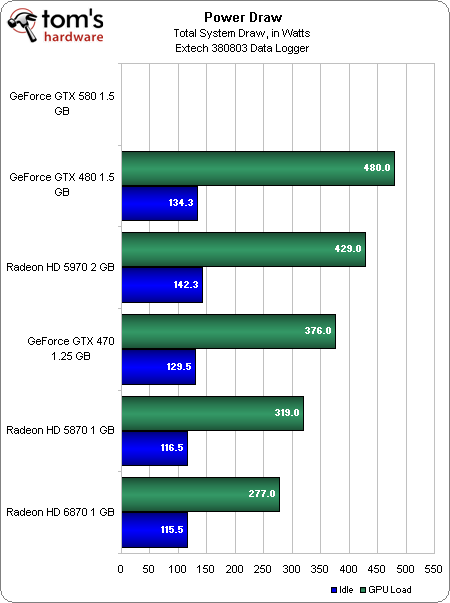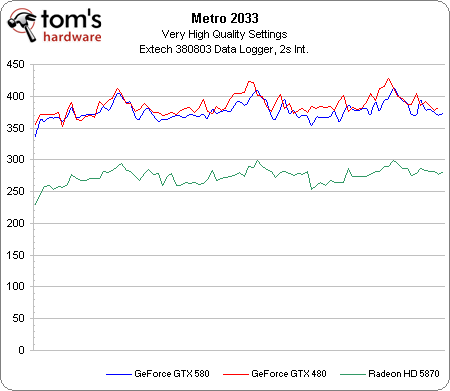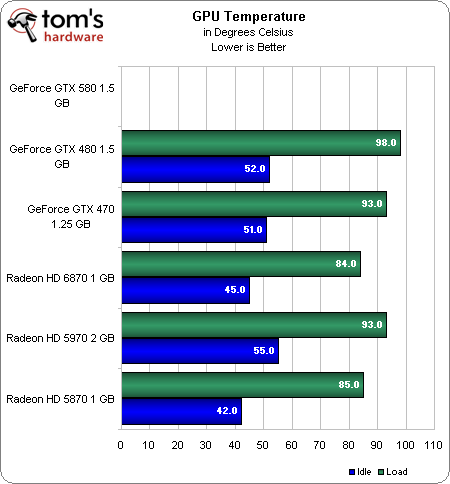GeForce GTX 580 And GF110: The Way Nvidia Meant It To Be Played
After an arguably disappointing GeForce GTX 480 launch back in March, we knew the company had to be working hard on a successor. Meet its flagship GeForce GTX 580, based on the GF110 GPU. This time around, Nvidia proves the idiom "better late than never."
Benchmark Results: Power And Heat
How about that for an interesting chart? The GF100-powered GeForce GTX 480 sits on top, ahead of the dual-GPU Radeon HD 5970, under load. The GeForce GTX 470 is the third-highest consumer here, with the Radeon HD 5870 and 6870 behind.
Notice that the GeForce GTX 580 isn’t even represented. The protection circuitry that Nvidia added prevents the card from running FurMark without throttling down. So, the maximum power shown appears to be lower than the GTX 470, though that’s clearly not realistic. AMD and Nvidia have long despised FurMark for its ability to inflate consumption figures, and now it looks like they're finally going to get to see it phased out.
Instead of leaving out power measurement altogether, we logged consumption in Metro 2033 across three runs of the demanding title’s built-in benchmark. The result is telling for a few reasons. First of all, the GeForce GTX 580 and 480 sit within 9 W average power use across the tests. This is because Nvidia shot for higher clocks and all 16 SMs enabled with GF110, bringing power back up to GTX 480 levels. Fair enough.
More interesting is that the Radeon HD 5870 and GeForce GTX 480/580 are separated by only about 100 W here. FurMark would have us believe that this gap is close to 160 W. That’s still a pretty significant number, though. We continue to be impressed with the performance AMD’s Cypress GPU delivers compared to the power it draws.
Measuring temperatures similarly becomes difficult without the ability to apply a consistent, demanding load, and FurMark again falls short there. We’re left with the scores gleaned from the GeForce GTX 480, which should be somewhat similar given the 580’s comparable TDP rating.
What’s not taken into account, however, is the redesigned cooling mechanism, which is more effective. GeForce GTX 480 presented Nvidia’s engineers with a challenge in this regard, and they came up shy of “good.” The enthusiast community lit a metaphorical fire under their asses, and we have a card that’s much more capable of coping with similar thermal output.
The difference in SLI is most telling. Our Falcon Northwest-based test platform’s Scythe fan was noisier than the two 580s under load in Metro. You’re still encouraged to space both cards three slots apart, but at least now we’re making a concession that yields usable acoustics under load.
Get Tom's Hardware's best news and in-depth reviews, straight to your inbox.
Current page: Benchmark Results: Power And Heat
Prev Page Benchmark Results: SLI Next Page Conclusion-
KT_WASP The last bit of the article is the most important I think. Anyone who drops $500 on this card right now, before Cayman releases, should have their head examined. With two companies releasing so close together, it would be in a person's best interest to see what the other is bringing to the table before shelling out such a large chunk of change.Reply
If the 6850 and 6870 have shown one thing.. they are much better then the last gen in many ways (power, noise and scaling) and the cayman is much more robust then the barts. So, before you start calling a winner here, wait and see. That is my advise. -
awood28211 Sound performance but the game here seems to be...double leap-frog. You can just release a product that competes with the competitors current offerings, you gotta compete with what he releases next... If AMD's next offering is significantly faster than it's current, then NVIDIA will still be playing catchup.Reply -
Wheat_Thins Kinda pointless article other then the fact that the 580 offers superb performance but until I see power and noise set in stone I honestly don't care.Reply
A single GPU nearly outperforming a 5970 is quite a statement. Wonder if AMD has what it takes to answer this as the 6850 IMPO is pretty disappointing other then the price. -
nevertell So it's basically what the 480 should have been. Fair enough, I'll wait for the 470 version of the gf110 and buy that.Reply -
TheRockMonsi The price right now for this card is way over $500 on newegg. For that price NVIDIA better be giving me a bj as well.Reply -
It'll certainly be interesting, even if i don't agree with NVIDIA playing catchup. The 480 had its flaws, but it still was the fastest single GPU around.Reply
We'll see what the 69xx have to offer. NVIDIA releasing now puts somewhat of a time constraint on AMD though. If it takes them too long to get something out the door, even some people waiting now may just get the 580 for christmas. -
kevin1212 Nvidia is embarrassed by the power draw of the gtx 580, haha. Improvement in performance but uses the same amt of power... still not a big enough improvement in efficiency, and no big leap in value either. AMD will wipe the floor with this card.Reply
By the way, i know you guys decided to drop crysis, and i can understand that, but given that this is a high end card, maybe you should have considered it, since frankly anyone buying a card like this would probably want it for crysis more than anything else. A 6870 is more than enough for the others. -
iamtheking123 Looks to me that the 580 is somewhere between a 5870 and a 5970. Might have been more impressive if it was Q2 2010 and not Q4 2010.Reply
With ATI's meat-and-gravy bits of the 6000 series on the launchpad, you'd be an idiot to buy one of these at this price.



